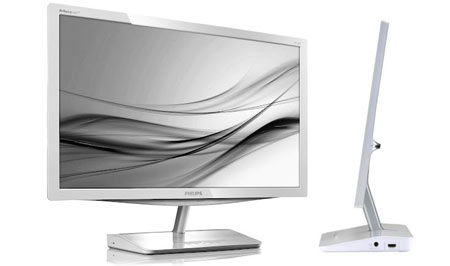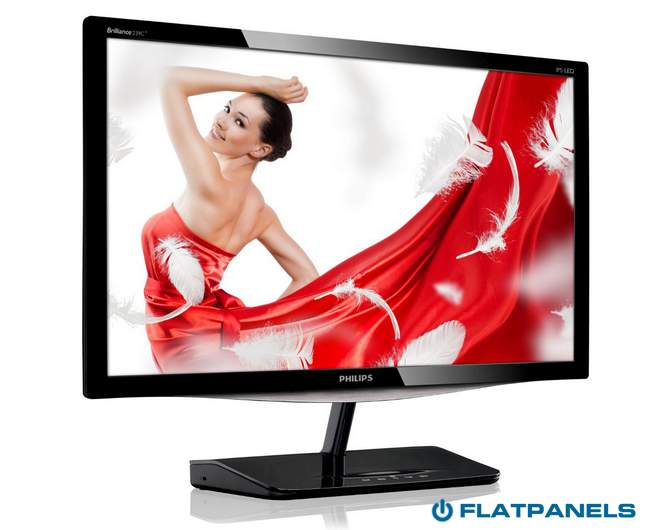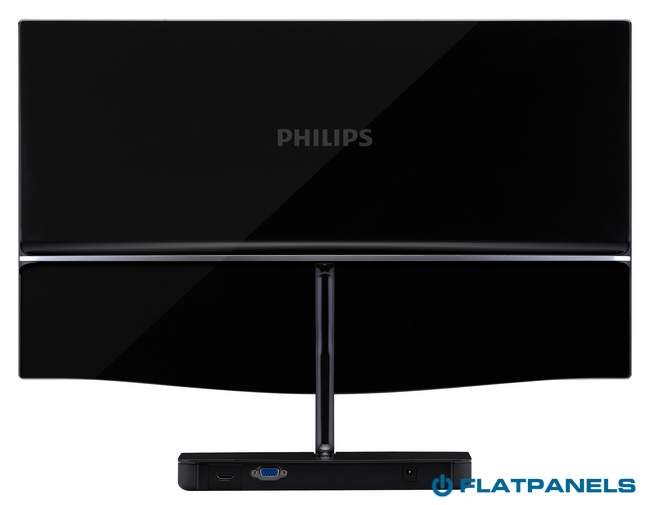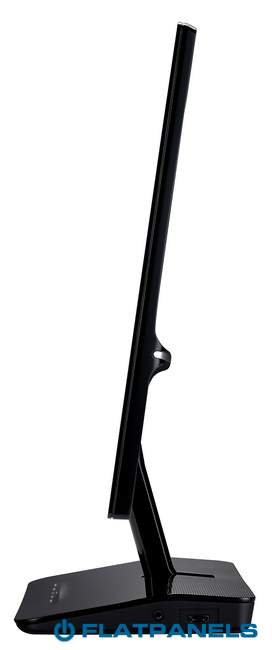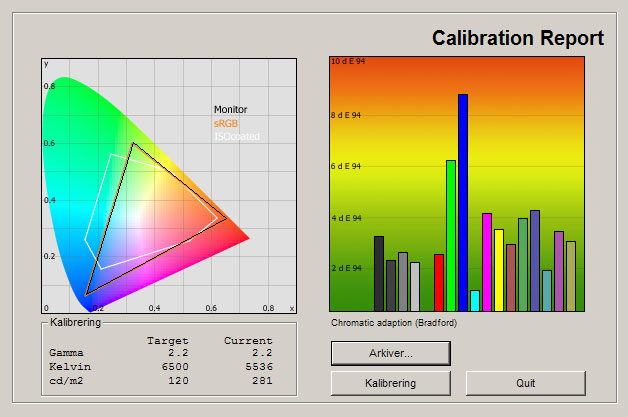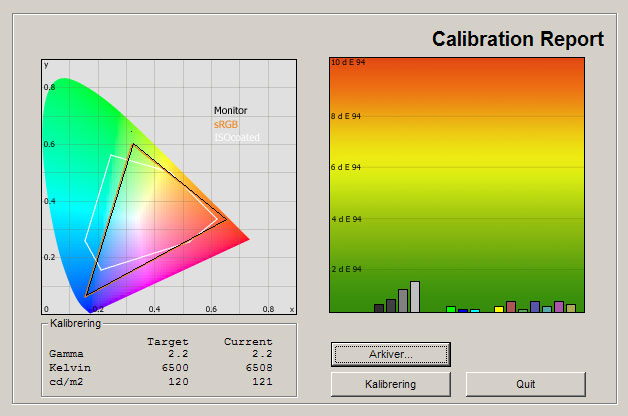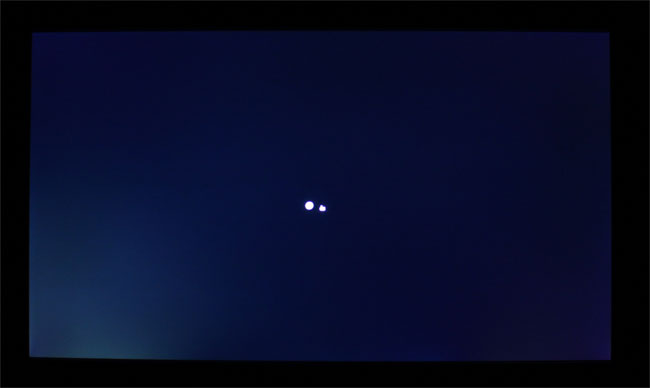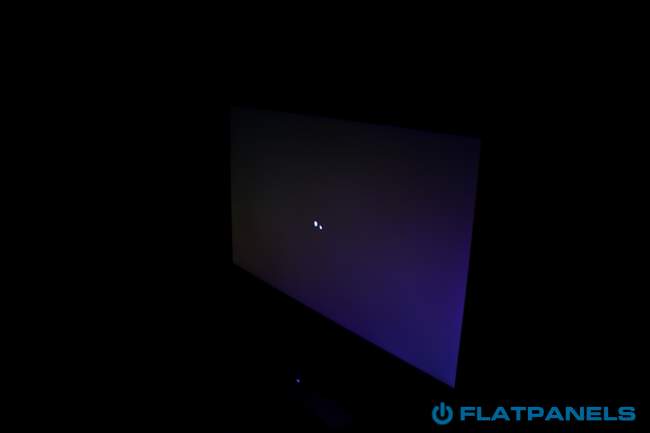Review: Philips Blade 2 (239C4QHSB)
Our first impressions - Energy consumption - Test tools - Picture quality - Response time and games - Viewing angles - Conclusion - Debate
Philips Blade 2 - or 239C4QHSB – is a new inexpensive monitor based on the IPS panel technology. Philips aims to challenge the cheap TN based monitors available today with a low-cost alternative, just like AOC has done with its I2353PH. The monitor also boasts a 6 ms (g2g) response time, an extremely slim 12.5 mm design and edge LED.
But has Philips created a better solution than the TN based monitors? Maybe even a low-cost monitor for photographers? FlatpanelsHD will find out in this review.Price and retailer:
| US retailer | UK retailer |
 |
| Size: | 23" Wide |
| Resolution: | 1920x1080 |
| Response time: | 6 ms (g2g) |
| Contrast ratio: | 1000:1 |
| Brightness: | 250 cd/m2 |
| Color support: | 16.7 million colors |
| Signal processing: | 8 bit for each color |
| Viewing angles (H/V): | 178/178 |
| Dot pitch: | 0.265 |
| Panel type: | IPS panel |
| Wall mounting: |  |
| Dimensions (HxWxD): | 33.7cm x 55.0cm x 3.4cm (without stand) |
| Weight | 3.0 kg |
| Built-in speakers: |  |
| Ergonomics | |
| Tilt |  |
| Swivel |  |
| Height |  |
| Pivot |  |
| Inputs | |
| VGA |  |
| DVI |  |
| DisplayPort |  |
| Audio (type) |  |
| S-video |  |
| Composite |  |
| Component |  |
| HDMI |  (2) (2) |
| Other |
Join our Newsletter, Facebook, twitter, YouTube or RSS to receive notice when new reviews are online
Our first impressions
Philips’ Blade 2 monitor is extremely slim, and even though it is not besting AOC I2353PH, Philips has created one of the slimmest monitors available on the market today.One of the tricks is to move all input connectors to the base. Here we found 2 HDMI ports (1 on the side and 1 on the back), 1 D-SUB (VGA) and the power connector. The power supply is external.
The monitor is made from glossy, black plastic that feels a little cheap. It does resemble most new monitors released today but has a distinctive grey bar at the bottom of the frame, just like some of Philips’ TVs. All of the touch-enabled buttons have also been moved to the base.
The monitor offers tilt adjustment but no height or swivel adjustment.
Energy Consumption
Compare power consumption measurements on different TVs and monitors with our interactive power consumption applet here.You can see our energy measurements on Philips Blade 2 below.
 |  | |
| Standby | 0.2 W | 0.2 W |
| PC | 35.2 W | 24.8 W |
After calibration we measured energy consumption to 24.8 W, which is far lower than the 23-24” monitors we examined in the last few years but on par with the recently introduced 23-24-inch monitors with edge LED backlighting.
Test tools
We use the DVI input for testing. The graphic card is Geforce GTX260.The monitor has been measured and calibrated with a LaCie Blue Eye Pro. We also examine the monitor with the help of our monitorTest. And finally we test the monitor in games, movies etc.
Picture quality on Philips Blade 2
Out-of-box picture quality on Philips Blade 2 is measured below in the Standard picture preset with Eco settings deactivated.The graph says this:
The number on the left is the delta value. Delta is a difference between two factors; here it’s the difference between the measured color on the panel and the actual color that is our target.
The out-of-box picture settings are impressive for a monitor in this price class. Especially the color deviations are low due to accurate gamma tracking, which is also evidenced in the graph above. Only a few colors have deviations over delta 4. Most are below.
Brightness is too high and was measured to 281 cd/m2 but this is a simple matter of adjusting the brightness setting in the menu. The color temperature is also slightly too low compared to our target value of 6500 Kelvin, which means that pictures are slightly too warm and reddish but it is not a very big concern.
It is quite impressive to see such accurate picture characteristics from a monitor this cheap. Philips even comes close to Dell U2312HM and Eizo FS2331, and beats the direct competitor AOC I2353Ph in the same price range.
We always want to squeeze out the last drops of performance so we tried to calibrate the monitor.
After calibration the monitor manages to reproduce very accurate and great-looking pictures. This was expected but compared to out-of-box performance most users will probably never notice the difference.
Our calibrated settings are shown below.
 | |
| Picture preset: | Off |
| Brightness | 50 |
| Contrast | 50 |
| SmartKolor: | Off |
| SmartTxT | Off |
| SmartResponse: | Faster |
| SmartContrast | Off |
| Gamma | 2.2 |
| Pixel Orbiting | Off |
| Overscan | Off |
| Color | User Define |
| Red | 99 |
| Green | 94 |
| Blue | 100 |
Note: Aim for a slightly higher brightness value if you mainly use your monitor in very bright environments. Avoid using the different color profiles such as “game”, “sports” etc.
I moved on to examine color gradation and even though we saw some bands in our gradient tests, Philips’ monitor did quite well. It is not a monitor for discerning graphic artists or professional photographers but it outperforms TN based monitors, and is adequate for amateur or casual work. The monitor had some problems with the darkest color tones just like all other IPS panels, but it is not a huge issue. I would rate it on par with AOC i2353Ph but below Eizo FS2332 and Dell U2312HM.
Philips has chosen a Full HD panel and this seems to be the norm for 23-24” monitors nowadays. Personally I would prefer a slightly higher resolution on a panel in this size class but for an all-round multimedia monitor, Philips has probably made a wise choice with the 1920x1080 resolution as it allow users to connect gaming consoles or movie players in addition to the PC.
In our AOC i2353Ph review we noticed that the panel had a better anti-reflective coating than most other IPS panels and that the grainy / crystallized look was reduced considerably. Philips Blade 2 seems to be using pretty much the same panel, because our experience is very similar. It has the “dirty screen” look when reproducing bright colors, such as white, but it is less noticeable compared to other IPS panels on the market – which is obviously a good thing.
Below I have measured black depth, brightness and contrast.
 |  | |
| Black level | 0.36 cd/m2 | 0.20 cd/m2 |
| Brightness | 281 cd/m2 | 121 cd/m2 |
| Contrast ratio | 781:1 | 605:1 |
Contrast ratio +/- 50
After calibration we measured black depth to 0.20 cd/m2, which is fair but not great. Dell U2312HM, AOC I2353Ph and Eizo FS2332 all beat Philips in this regard but only by a very small margin. The VA monitors and some TN based monitors still outperform IPS monitors in this area but compared to the direct competitors Philips is pretty much keeping up. Still, the black color on the monitor panel looks noticeably greyish in a dimly lit room.
Shadow detailing is on par with most IPS panels and we were able to distinguish most tones of dark grey on the panel. Only the 1-2 tones closes to black were not reproduced perfectly on Philips’ monitor.
Lastly, I examined the Philips monitor in a completely dark room to check for clouding / backlight bleeding issues.
Unfortunately our review sample had some heavy bleeding in the bottom left corner and some purple-tinted bleeding in the bottom right corner. It clearly shows during everyday use and most visibly during movie watching with black bars. This is a shame because performance has been pretty decent up until now.
Response time and games
Response time is still important because even though monitors are becoming faster no LCD panel is totally blur-free. Philips has incorporated an overdrive circuit into the panel that is controlled via the SmartResponse setting option in the menu. You can choose from Off, Fast, Faster and Fastest. Unfortunately the different settings have little or no effect. We saw no overdrive trailing (which is great), not even in the “fastest” profile, but we noticed motion blur during our stress tests.We had expected Philips’ monitor to perform like most other inexpensive IPS monitors but unfortunately it came out behind the closest competitors. 120 Hz TN panels are obviously still preferred for serious gaming purposes but for example Eizo FS2332 is also noticeably faster than Philips’ monitor. During movie watching Philips Blade 2 did quite well but during fast-paced FPS gaming we noticed blurring that became mildly distracting at times.
Input lag was measured to 18-22 ms.
Viewing angles
The viewing angles are fairly wide but not best-in-class. Compared to more expensive IPS monitors, Philips Blade 2 is a bit darker when watched from an angle. Color wash-out is not a big problem and the viewing angles are wider than on every TN or VA based monitors out there - but the viewing angles are not perfect.Also, Philips’ monitor has the same contrast issues as other IPS monitors. See below.
Conclusion
Philips Blade 2 - or 239C4QHSB – is the latest in the line of inexpensive IPS based monitors. It is extremely thin, measuring just 12.5 mm in depth, due to the edge LED backlight. All input connectors have also been moved to the base. The monitor feels a bit cheap for Philips’ standards but is not much different from the majority of TN based monitors today.The first thing we noticed on Philips’ monitor was its excellent out-of-box color accuracy. We have seen this on IPS monitors before but it is rare to experience it in this price class. We calibrated the monitor but for most users the calibration process is basically obsolete on this monitor, at least if you do not own a hardware calibrator. Philips’ monitor is also pleasant to work at and the “dirty screen” look that plagues some IPS monitors is subtler on this panel. Unfortunately, black depth is not impressive and response time is subpar. But most importantly, our review sample had terrible clouding issues, which kind of ruined the show. We know from experience that clouding/bleeding can vary a lot from sample to sample, so we hope we had a bad sample, but we would love to hear your experience.
To summarize, Philips’ Blade 2 monitor has its strengths and is in the same class as AOC i2353Ph. I would probably recommend it over every TN based monitor out there (except for gaming purposes) but I also think that it is worth investing the few extra bucks in for example Eizo FS2332 or Dell U2312HM if you are looking for an IPS based monitor.
Price and retailer:
| US retailer | UK retailer |
 |
Picture quality is assessed as overall picture quality, including color reproduction, contrast, viewing angles etc.
Features is an evaluation of the built-in functionality how useful it are, as well as sound quality and ports
Speed is an evaluation of how good the monitor is for gaming, meaning response time, Hz, input lag, overdrive etc
Ergonomics is an evaluation of adjustment options, stability, power consumption, degree of flicker etc.
Total score weighted as: 40% Picture quality, 25% Features, 25% ergonomics and 10% Speed.
All scores are calculated based on a moving maximum target, defined by what we currently consider the best on market. It is then presented as a percentage. This means that a score will fall over time as new and better monitors set new standards. This allows you to compare scores across years. A score of 100% in a given category means that it is consider the best available monitor in this category to date.
Features is an evaluation of the built-in functionality how useful it are, as well as sound quality and ports
Speed is an evaluation of how good the monitor is for gaming, meaning response time, Hz, input lag, overdrive etc
Ergonomics is an evaluation of adjustment options, stability, power consumption, degree of flicker etc.
Total score weighted as: 40% Picture quality, 25% Features, 25% ergonomics and 10% Speed.
All scores are calculated based on a moving maximum target, defined by what we currently consider the best on market. It is then presented as a percentage. This means that a score will fall over time as new and better monitors set new standards. This allows you to compare scores across years. A score of 100% in a given category means that it is consider the best available monitor in this category to date.
Color accuracy
Price
”Dirty-screen” reduced
IPS panel
Power consumption
Clouding/bleeding issues
Black level
Response time

